World of Tanks news » The Chieftain's Hatch: Al Fahd, The Best Tank You Never Heard Of

For today’s Hatch, we go South of the equator, to that well-known bastion of tank production, Brazil! I've never been there, I suggest we should have a player gathering on the beach in Rio. I wonder who else would attend? Anyway, I digress. It’s the local independence day down there, thus providing our first tenuous link to the very Portuguese tank name of “Al Fahd”
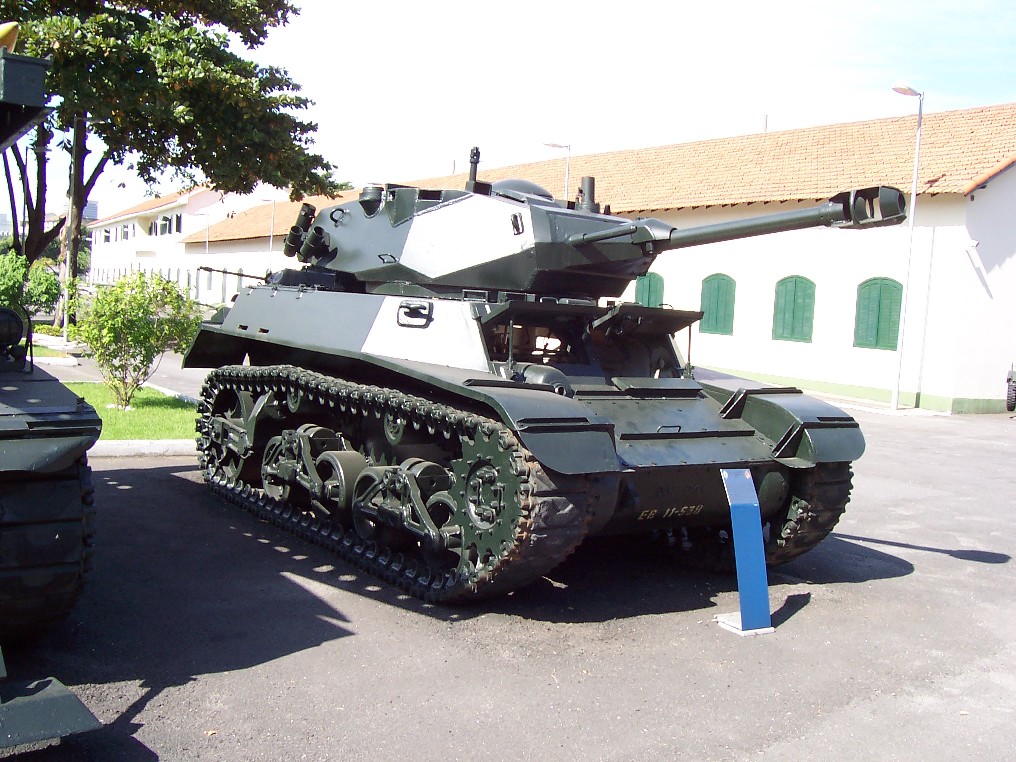 The X1A (It's an M3 Light, honest)
The X1A (It's an M3 Light, honest)
Tanks aren’t really a huge deal in South America. Many of the countries down there have all but no tankable terrain to start with, and those that do haven’t seen any need to buy top of the line, possible exception of Venezuela. There may have been an economic driver as well: As tank costs grew to the millions of dollars per unit, the local governments had better things to spend their money on than top of the line armour. As a result, the region is filled with a history of upgrades and modifications to equipment which every right-thinking-nation had discarded as obsolete. The regional powerhouse, Brazil, was not immune to this.
If you think their M3 Stuart upgrade program was impressive, you should see what they tried with the M41 design. Anyway, if you are curious what happened to the turrets of those M3s, a number of them were given to a local company called Engesa (Engenheiros Especializados S/A) who were making armoured cars.
 Cascavel 1. Wonder where they got the ammo?
Cascavel 1. Wonder where they got the ammo?
Hopefully you’re following the path here…
Engesa was a rather successful little business, initially doing quite the line of upgrades, and then entering the new-vehicle-manufacturing sector entirely. EE-3 didn’t rock the world, but the larger EE-9 and EE-11 vehicles went to the four corners of the Earth. All was going well, until someone sitting in the office on Avenue das Nacoes Unidas in Sao Paolo had a visit from the Good Idea Fairy.
Engesa figured that the Brazilian Army might be interested in a domestically produced tank of far greater capability than the vehicles which were considered obsolete by most every other continent and were still in Brazilian service. Not to mention also that it would make domestic politicians happy: Just think of the jobs!
Indeed the Brazilian Army were interested and laid out some basic specifications. Can’t be too heavy (about 35 tons) and must fit on the local railway loading. There was only one catch: Brazil couldn’t afford to pay for the development of the tank: They would only purchase if they could split the costs with other buyers. As a result, the tank Engesa was to build had to be an export tank. No export sales, no domestic sales. The problem was that Brazil didn’t want an MBT. They wanted a capable lighter tank for their own domestic needs and maybe peacekeeping duties. The export world wanted an MBT.
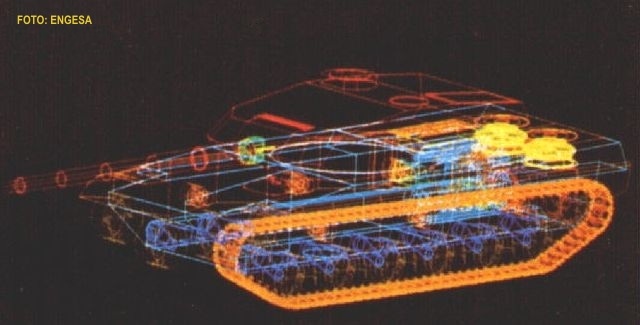 The Bazilians made the first CAD tank, it is claimed
The Bazilians made the first CAD tank, it is claimed
The first thing Engesa did was ignore the Brazilian Army’s weight requirements. Nobody buying a high-tech tank was going to be particularly interested in something coming in at 36 tons, in a market dominated by vehicles 45-62 tons in weight. Particularly kept in mind was the Middle-East, an area that the company had had prior success and which was known to have the money to burn on tanks. They still kept a ‘lite’ version, still over 40 tons, for Brazil and using the L7 105mm rifle, but the export focus was on something bigger. To keep the Brazilians happy, however, they named the project after General Manuel Luís Osório, the father of the Brazilian Army’s Cavalry branch. Another stated reason for the name was that it was actually pronouncable by non-Portuguese speakers (EE-3’s ‘Jararaca’ apparently is very hard to get right). The nomenclature was the EE-T1..
 Another tank which you never heard of.
Another tank which you never heard of.
After some initial attempts to engage in a partnership with other companies, the company decided that it was going to try to develop the tank completely independently. They were not, however, adverse to borrowing or licensing other ideas. After all, they had never built an MBT before. One of the companies they went to was Vickers, who had been trying, generally unsuccessfully, to plug their own tanks on the export market. In effect, the turret on Osorio is a Vickers turret modified to Brazillian design, so similarities between the Vickers Mk7 above and EE-T1 are not coincidental.
ZF actually had a transmission plant in Brazil at the time, so at least that part of the tank was a no-brainer, and the MTU of Leopard was selected for local production. Unfortunately, MTU turned out to be a bit pricey, so they went with a 1,040hp MWM TBD 234 instead. Hydrogas suspension was also borrowed from the British, and the omnipresent Diehl tracks were selected.
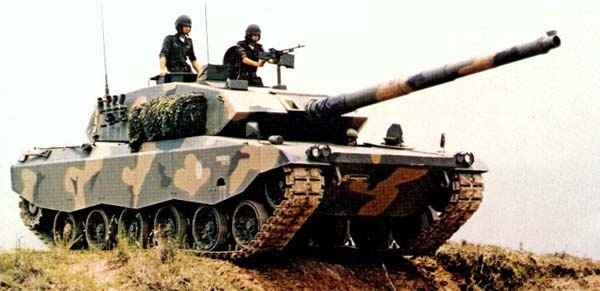 In fairness, not a bad mockup.
In fairness, not a bad mockup.
The first hull was finished in Sept 1984 and fitted out with a fake turret, then rolled out to the press to great fanfare. Eventually a functioning ‘Brazilian’ turret arrived in May 1985. By the standards of Brazilian armour at the time (and, in fairness, of more than a few other countries), it was quite a piece of kit. The 105mm cannon was capable of dealing with anything else on the continent, and it was equipped with passive image intensification equipment for night fighting and the OIP fire control system for firing on the move with gun stabilised and sight linked. The armour itself was composite, and rated to stop at least 105mm. Most ammunition was stored in the bustle, separated from the crew compartment by an armoured door.
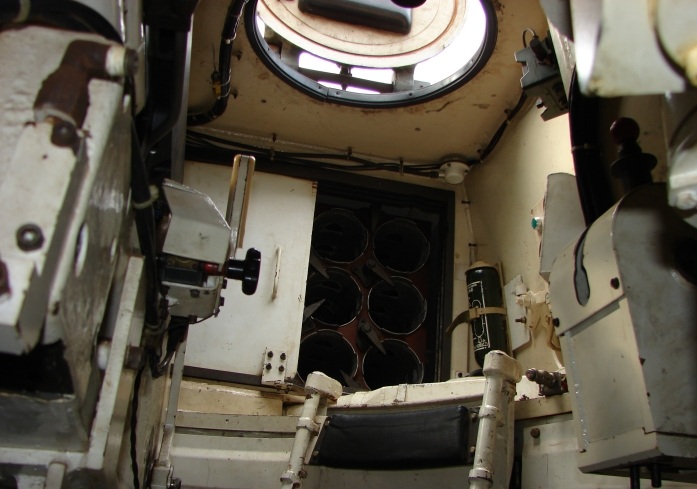 Familiar concept
Familiar concept
Combined with the second hull to be completed (the only one to have the exhaust port on the hull side) it was immediately sent to Saudi Arabia for desert trials. The export turret still wasn’t built yet, but at least some of the bugs could be worked out with the chassis, and indeed there were some to be dealt with. Still, for a project which was started in 1983, they weren’t doing badly.
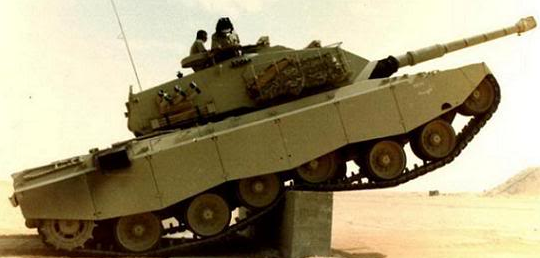 Second vehicle on trials with the first turret.
Second vehicle on trials with the first turret.
Upon return to Brazil, the turret was put onto the first hull, and the export turret was dropped in a few months later. They weren’t mucking around with this one, and put in almost every whizzbang they could think of. The image intensifiers of the standard turret were replaced by thermal imagers for both the TC and gunner (each also had his own laser rangefinder), an air conditioning system was added (handy in the desert), auxilliary power unit, NBC system, laser warning receiver, a proper dual axis stabilised Marconi fire control system (16 bit!) with the mirrors independently stabilised and, oh yeah, a Bigger Gun (TM). The cannon they selected was the GIAT 120mm smoothbore, familiar today as being the cannon found on Leclerc. The turret was intended to protect from 120mm cannon. Doesn’t sound all that impressive nowadays in the world of Leopard 2A5 and M1A2, but remember back then even M1A1 had barely been built, the first one was only produced a few months earlier.
 Sun, sand, sea, and a 120mm smoothbore. Life can be good...
Sun, sand, sea, and a 120mm smoothbore. Life can be good...
In July 1987, the Brazilians again left the bikini-filled sands of Sao Paolo for the ‘bikini? Stone her!’ sands of Saudi Arabia, this time to do battle against the forces of evi... erm.. the beacons of the Western world: Challenger, M1A1 and AMX-40. The tank held its own well enough over the course of the tests, crewed by a randomly selected group of Saudi Army soldiers. It was the only tank to hit the 4,000m target, and literally pulled above its weight: For the 10km tow it was supposed to be able to haul 35 tons; instead, it hauled the M1A1. The tests covered basic capabilities like crossing a 3m trench, to more difficult ones like averaging 2.4km/litre cross-country. Challenger and AMX-40 both failed the requirements outright, with only M1A1 and EE-T1 making the grade. On the comparative capabilities, EE-T1 beat M1A1 silly, and so the Saudis announced EE-T1 as the winner of the competition, with an order to be placed for 318 tanks to be known locally as “Al Fahd” (See? There’s the link!). It also didn’t hurt that Osorio was going for a unit cost of about $1.2m, whilst M1A1 ran closer to $2m.
As you can imagine, this made the Brazilians rather happy. For an encore, they went to Abu Dhabi the next year for more trials, this time including the C1 Ariete. It won again. A pre-production run of Al Fahds was started, and plans made to expand the Sao Paolo factory.
 So what happened? Well, the short answer is ‘politics.’ Partially American pressure, and partially Brazil’s own opportunism. Engesa didn’t seem all that picky about who it sold its equipment to, and its list of customers included a few local nations that the Saudis weren’t on such great terms with, a fact that the US was apparently not shy in pushing. It is often stated that the 1990/91 war was the catalyst for the eventual Saudi procurement of M1, as something of a return of favour for the US helping out, but US Congress had been notified of the pending Abrams sale to Saudi in late 1989.
So what happened? Well, the short answer is ‘politics.’ Partially American pressure, and partially Brazil’s own opportunism. Engesa didn’t seem all that picky about who it sold its equipment to, and its list of customers included a few local nations that the Saudis weren’t on such great terms with, a fact that the US was apparently not shy in pushing. It is often stated that the 1990/91 war was the catalyst for the eventual Saudi procurement of M1, as something of a return of favour for the US helping out, but US Congress had been notified of the pending Abrams sale to Saudi in late 1989.
That was just the start of Engesa’s troubles. The 90/91 war did have a direct effect in that Iraq wasn’t in a position to pay for some of the products that they had received from Engesa, and to make things worse, the end of the Cold War also meant that there was quite a glut of reasonably capable and very reasonably priced tanks also available on the market, also joined by Leclerc at the high end. The end result was that EE-T1 never did make an export sale, and Brazil’s army wasn’t about to shoulder the price on its own. The company couldn’t withstand the costs of the tank’s development on its own either, and the whole ship went under, the company filed for bankruptcy in 1993.

As for the tanks themselves, last I heard they were still in Sao Paolo, in the custody of the Army. At least one has a support strut welded to the breech from the turret roof to keep the gun from falling. On occasion one will be dragged out for a parade, causing mass confusion as people suddenly think it's a new tank or one in service.
Osorios are still being made, however. I have the Trumpeter kit, which I built a couple of years ago. As soon as I put it down on the table at the club, they know it's a "Nicholas" kit: Modern and unidentifiable! Unfortunately, being an early Trumpeter kit, it's horrible, but if you want an Osorio sitting on your desk, it's your only option. I've been keeping an eye on this thread for a while, he started superdetailing his kit in May 2009, as of last week, he still hadn't quite finished it. More patience than I have.

As a business venture, EE-T1 was a disaster. They really tried to do too much with it, gambling the entire company's future on what was really neither fish nor fowl. As a technological achievement, an exercise in making a great tank,however, the guys in Sao Paolo were leaving the rest of the world behind them.
By the way, I'm still accepting 'likes' for my Facebook page.















 Update comments
Update comments